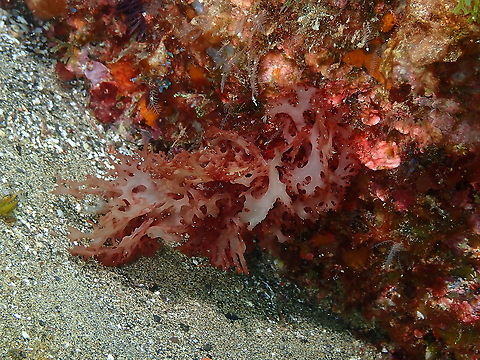
Appearance
Thallus (gametophyte) light pink to red-brown, mucilaginous, erect or partially decumbent, pliable but turgid, to 13 cm tall and 20 cm wide, with a small discoid holdfast. Branching irregular, commonly with foliose portions and numerous marginal proliferations, rarely with narrow axes. Axes to 10–30 mm wide and 1.4–2.2 mm thick, tapering abruptly to 0.5–2.0 mm wide and 0.5–1.7 mm thick near apices. Secondary anastomoses between branches common. Structure multiaxial, with a diffuse apical meristem. Medullary filaments with cells 80–270 µm long and 5.0–15.7 µm in diameter. Cortex 5–12 cells thick, with ellipsoidal inner cells 15–35 µm long and 10–15 µm in diameter and subspherical surface cells 3.5–4.5 µm in diameter. Intercalary obovoid gland cells (25–50 µm long and 20–45 µm in diameter) common in the cortex and occasionally present in the medulla.Naming
Platoma cyclocolpum (Montagne) F.Schmitz 1894: 627 (footnote), 628 (as 'cyclocolpa' )Published in: Schmitz, F. (1894). Kleinere Beiträge zur Kenntniss der Florideen. Nuova Notarisia 5: 608-6
Homotypic Synonym(s)
Halymenia cyclocolpa Montagne 1841
Nemastoma cyclocolpum (Montagne) Zanardini 1843
Heterotypic Synonym(s)
Halymenia cervicornis J.Agardh 1842
Nemastoma damicorne Harvey 1855
Distribution
Méditerranean Sea, East Atlantic, Manche Canal and North Sea, Caribbean, Indo-Pacific. Known from Cape Bouvard north to the Dampier Archipelago, W. Australia; also on the Canary Islands.Habitat
P. cyclocolpum occurs subtidally to depths of 20 m, generally on the sides or at the bases of limestone reefs in relatively low light. In the lower intertidal zone to depths of 18 m; epilithic and generally attached to the sides or at the base of rocks in relatively low light conditions and in places of moderate wave action; frequently associated with encrusting Corallinaceae, sometimes on top of patches of Codium adhaerans and less frequently among Corallina tufts. Attached to rocky substrata at depths of 5-20 m.Reproduction
Plants monoecious. Spermatangia (4–6 µm long and 2.5–4.0 µm in diameter) in sori, solitary or paired on outer cortical cells. Generative auxiliary cells are transformed mid-cortical cells. Gonimoblast arising from the upper surface of the generative auxiliary cell, eventually producing a spherical carposporophyte 140–200 µm in diameter composed entirely of angular or spherical carposporangia 12–20 µm in diameter. Mature carposporophytes largely immersed in the thallus, although a slight protuberance and rudimentary ostiole are visible from the surface. Tetrasporangia not observed.References:
Some text fragments are auto parsed from Wikipedia.
https://www.algaebase.org/search/species/detail/?species_id=678http://www.marinespecies.org/aphia.php?p=taxdetails&id=144175
https://florabase.dpaw.wa.gov.au/browse/profile/27144